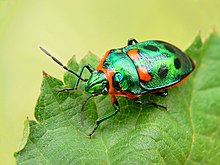
Australian cuisine is the food and cooking practices of Australia and its inhabitants. Australia has absorbed culinary contributions and adaptations from various cultures around the world, including British, European, Asian and Middle Eastern.

The Blue Mountains are a mountainous region and a mountain range located in New South Wales, Australia. The region is considered to be part of the western outskirts of the Greater Sydney area. The region borders on Sydney's main metropolitan area, its foothills starting about 50 kilometres (31 mi) west of centre of the state capital, close to Penrith. The public's understanding of the extent of the Blue Mountains is varied, as it forms only part of an extensive mountainous area associated with the Great Dividing Range. As defined in 1970, the Blue Mountains region is bounded by the Nepean and Hawkesbury rivers in the east, the Coxs River and Lake Burragorang to the west and south, and the Wolgan and Colo rivers to the north. Geologically, it is situated in the central parts of the Sydney Basin.

Macrotis is a genus of desert-dwelling marsupial omnivores known as bilbies or rabbit-bandicoots; they are members of the order Peramelemorphia. At the time of European colonisation of Australia, there were two species. The lesser bilby became extinct in the 1950s; the greater bilby survives but remains endangered. It is currently listed as a vulnerable species. The greater bilby is on average 55 cm (22 in) long, excluding the tail, which is usually around 29 cm (11 in) long. Its fur is usually grey or white; it has a long, pointy nose and very long ears, hence the reference of its nickname to rabbits.
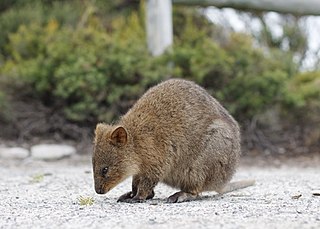
The quokka is a small macropod about the size of a domestic cat. It is the only member of the genus Setonix. Like other marsupials in the macropod family, the quokka is herbivorous and mainly nocturnal.

Australian limes are species of the plant genus Citrus that are native to Australia and Papua New Guinea.
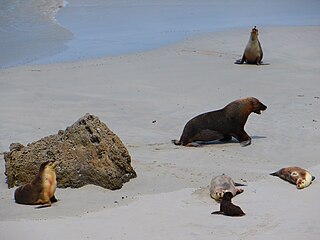
The Australian sea lion, also known as the Australian sea-lion or Australian sealion, is a species of sea lion that is the only endemic pinniped in Australia. It is currently monotypic in the genus Neophoca, with the extinct Pleistocene New Zealand sea lion Neophoca palatina the only known congener. With a population estimated at 14,730 animals, the Wildlife Conservation Act of Western Australia (1950) has listed them as “in need of special protection”. Their Conservation status is listed as endangered. These pinnipeds are specifically known for their abnormal breeding cycles, which are varied between a 5-month breeding cycle and a 17-18 month aseasonal breeding cycle, compared to other pinnipeds which fit into a 12-month reproductive cycle. Females are either silver or fawn with a cream underbelly and males are dark brown with a yellow mane and are bigger than the females.

The Australian National Botanic Gardens (ANBG) is a heritage-listed botanical garden located in Acton, Canberra, in the Australian Capital Territory, Australia. Established in 1949, the Gardens is administered by the Australian Government's Department of Agriculture, Water and the Environment. The botanic gardens was added to the Commonwealth Heritage List on 22 June 2004.

Robert Lyall "Alfie" Hannaford, is an Australian realist artist notable for his drawings, paintings, portraits and sculptures. He is a great-great-great-grandson of Susannah Hannaford.
The 1971 South Africa rugby union tour of Australia was a controversial six-week rugby union tour by the Springboks to Australia. Anti-apartheid protests came to being all around the country. The tour is perhaps most infamous for a state of emergency being declared in Queensland.
In total, around 700 people were arrested whilst the Springboks were on tour.

The western swamp turtle or western swamp tortoise is a critically endangered species of freshwater turtle endemic to a small portion of Western Australia. It is the only member of the genus Pseudemydura in the monotypic subfamily Pseudemydurinae.

The 2005 Supercheap Auto 1000 was an endurance motor race for V8 Supercars. The race was held on 9 October 2005 at the Mount Panorama Circuit just outside Bathurst in New South Wales, Australia and was Round 10 of the 2005 V8 Supercar Championship Series. It was the ninth running of the Australia 1000 race, first held after the organisational split over the Bathurst 1000 that occurred in 1997. It was the 48th in a sequence of endurance races which commenced with the 1960 Armstrong 500 held at Phillip Island and 2005 was the 43rd year in which these races had been run at the Mount Panorama Circuit. It was also the first to be run under new naming rights sponsor, Australian automotive retail chain Super Cheap Auto.

Cotula is a genus of flowering plant in the sunflower family. It includes plants known generally as water buttons or buttonweeds.
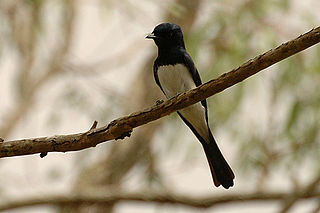
The satin flycatcher is a species of bird in the family Monarchidae. Males stand out with their blue-black feathers contrasting their white bellies, and the females with their bright orange throats. It breeds mostly in south-eastern Tasmania and Australia. It is declining throughout the eastern seaboard due to predation from the introduced Red Fox and habitat loss. It is a vagrant to New Zealand.
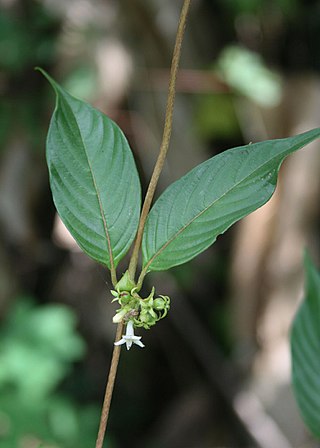
Sabicea is a genus of flowering plants in the family Rubiaceae. They are known commonly as the woodvines. The type species is Sabicea cinerea. There are about 145 species. Most are distributed in tropical Africa and South America.

Crataegus coccinea, the scarlet hawthorn, is a species of hawthorn around which there is considerable confusion because the name has been misapplied for a long time. It has been shown to be the same as C. pedicellata, and under the rules of botanical nomenclature, the older name should be used.

Saproscincus mustelinus, commonly known as the southern weasel skink or weasel shadeskink, is a small species of skink which is endemic to Australia.

Philotheca salsolifolia is a species of flowering plant in the family Rutaceae and is endemic to New South Wales and the Australian Capital Territory. It is a shrub with crowded, more or less cylindrical leaves and pink to mauve flowers with a dark central stripe and arranged singly or in twos or threes on the ends of branchlets.

Salix pedicellata is a species of willow. It is a shrub or small tree to about 6–8 m tall, native around the Mediterranean Sea from Portugal to Lebanon and Syria in the north and from the Canary Islands to Tunisia in the south. Salix canariensis may be treated as a subspecies of S. pedicellata.
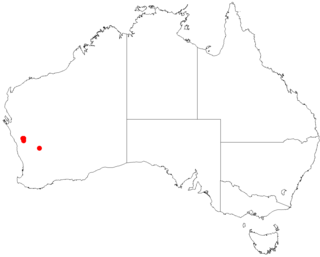
Prostanthera pedicellata is a species of flowering plant in the family Lamiaceae and is endemic to a restricted area of Western Australia. It is a small shrub with densely glandular branches, egg-shaped to oval leaves and red flowers.
Goodenia pedicellata is a species of flowering plant in the family Goodeniaceae and endemic to the Pilbara region of Western Australia. It is an perennial herb with a single stem, egg-shaped to trowel-shaped leaves with the narrower end towards the base, and racemes of yellow flowers on unusually long pedicels.
